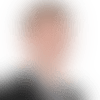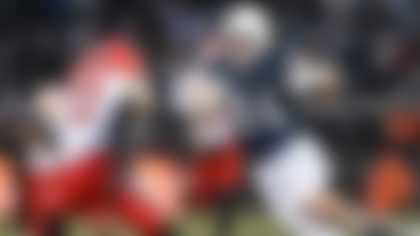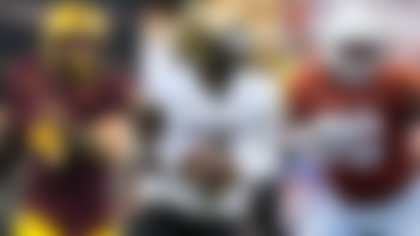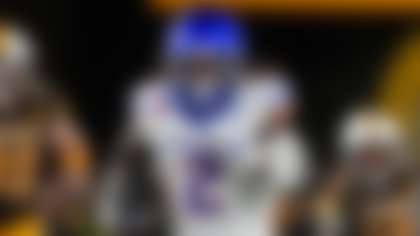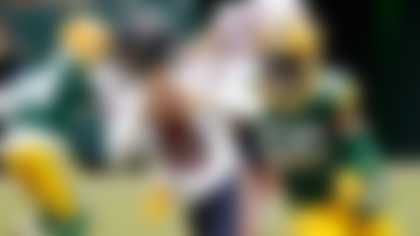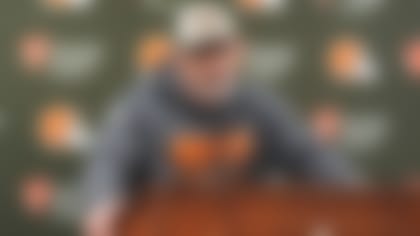The enormous windows of Lucas Oil Stadium framed a pale, blue, cloudless sky while keeping the chill of early March firmly at bay. Inside, gargantuan speakers hung silently above the field, which somehow seemed too brightly lit for midday, and the dull rush of recirculated air whirred in the background, as if the world's largest white-noise machine had been set at its lowest volume.
On a normal game day, details like those are no doubt swallowed up by a full house cheering on live football in the Indianapolis Colts' roofed stadium. On that day, though, not even the modest crowd that had gathered to watch quarterbacks throw to receivers at the NFL Scouting Combine managed to puncture the quiet, studious, almost respectful atmosphere.
Except for one moment. When Wyoming quarterback Josh Allen launched a towering, arcing ball nearly 70 yards downfield, an appreciative murmur descended from the upper levels -- a clear violation of the warning, which flashed occasionally on the stadium's video screen, that fans remain quiet.
Afterward, a buoyant Allen confirmed that performing in the relatively noiseless environment was "weird," citing the "cameras following you around all over the place." The crews stationed on the field, steps away from the prospects, served as a constant reminder of the television audience for these drills, which were ostensibly intended to help teams accurately identify quarterback talent.
By the time the average college quarterback is ready to play in the NFL, he's amassed a hefty record of game tape, proof of what he is capable of doing against live defenders in competitive situations with real stakes. But between the end of the college season and the draft, QB prospects are displayed in a limited number of strikingly un-gamelike settings, including the combine, a pro day and any private workouts teams might arrange. In each of those workouts, the prospects are asked to throw the football to receivers without defenders on the field, sometimes following their own plan, sometimes taking orders, but always throwing, attempting to repeat the motion to the satisfaction of the NFL coaches, GMs and scouts who will determine their professional fates.
With the pro-day schedule in full swing and the actual selection of the NFL's next crop of rookies still about a month away, this is the time of year when 20-somethings throwing footballs in shorts take center stage, when technical matters like mechanics and velocity and release points seem to be of utmost importance.
How much can these drills, these surreal simulacrums of football action -- stripped of the urgency, unpredictability and sheer stress of real life on the field -- really say? How much do they help teams in the eternal quest for people who are capable of playing quarterback in the NFL?
'I do want to see it live'
When it comes to evaluating quarterback prospects, the game tape is sacrosanct.
"For me, nothing is more important than watching tape and watching them play football against a defense, against a rush," Houston Texans quarterback coach Sean Ryan said. "Watching them react to game situations. I don't think anything substitutes that. Because when it's all said and done, when it matters, that's what they're going to be faced with."
"The value of seeing these guys in shorts and a T-shirt is really just to verify what you've seen on tape and seen in person," said Tim Jenkins, who trains quarterbacks through his company, Jenkins Elite. "No quarterback is going to make crazy jumps. You don't go from being a kid who nobody knows to being a kid who's drafted because you worked out well in shorts and a T-shirt."
"For a lot of these kids in this (year's draft) class, it's really for trying to change maybe what (NFL decision-makers have) seen on tape," Jenkins added. "If they've seen on tape that you're not accurate or they've seen on tape that you have biomechanical flaws, it's to show them that hey, in this setting, you can tell that I'm fixing these or I'm working on these."
Even prospect Tanner Lee, who spent significant time preparing for the combine and his pro day at Nebraska, pointed to the primacy of the tape.
"I think the good part about the draft process is that your film is really, first and foremost, the biggest part of your evaluation," Lee said two days after his pro day. "Film tells these scouts the most about how you perform when you're playing ball. Film is gold, and you're going to want to put your best foot out there, period, on your film."
And yet, before the Rams selected Jared Goff No. 1 overall in the 2016 NFL Draft, general manager Les Snead had to see him throw the ball with his own two eyes.
"You can feel the ball when you're there," Snead said at the combine, when asked about what he can see at throwing drills that one can't see on tape. "When we did Jared -- and he throws an interesting ball, because, and we've analyzed it right, but you can kind of hear it go by you. But it looks smooth. But what's interesting is, they, physically, they say it doesn't spin as much, like a tight, tight [spiral]. When a ball is spinning, it just looks faster. And when it's spinning less or rotating less, it may be faster, it just doesn't look that fast. But there's an element when you hear it or see it that you get up close and personal."
Every NFL head coach, GM and private QB instructor who was asked about watching quarterbacks throw in person against air -- either at the combine, a pro day or a private workout -- said it's important.
Colts coach Frank Reich: "I do want to see it live. I want to be on the field with them, watching the ball come off their hand."
Dolphins coach Adam Gase: "I think any time you can watch somebody throw live, it helps you. You can kind of see in between plays, kind of the reaction. How do they come back from a throw that wasn't really great?"
The quarterback position is complex, and those who attempt to man it must possess a vast skill set, including the ability to handle multiple responsibilities and perform a staggering array of mental tasks. At its most basic level, though, playing quarterback is about getting the football from Point A to Point B through the air.
"What's your job once you get into the NFL? Your job is not to hand the ball off on third down," said John Beck, a former NFL quarterback who helps prospects prepare for the pre-draft process as part of the 3DQB group led by Tom House and Adam Dedeaux. "The critical downs, usually those first downs are found through the air. So it's about throwing the football."
To perform that function reliably, one's throwing mechanics -- how the quarterback's feet, legs, body, arms and, of course, hand work in concert to launch the ball -- should be sound. And when it comes to evaluating mechanics, there's nothing like an in-person inspection. As Ryan explained it, mechanical consistency and rhythm are sometimes "not as easy to pick out" when watching game tape "as it is when it's just throw after throw of routes on air." Watching a quarterback throw on air, he said, allows him to "get a feel for this guy's rhythm. And it really comes down to a real sense of, you get a feel of, is his footwork consistent?"
"And then the same thing with the upper body," Ryan said. "As you kind of work your way up, it becomes, alright, let me check his release point. And that's always something I like to look at, because every guy's release point is a little bit different. It's a pretty individual thing. A lot of it's very personalized to them. And I just like to be able to check and see, is this consistent?"
Private quarterback coach Jordan Palmer, a former NFL quarterback -- and brother to recently retired Cardinals QB Carson Palmer -- has trained quarterbacks like Blake Bortles and Deshaun Watson and has been prepping Allen and USC's Sam Darnold. Palmer, who said he pays attention to sequencing in a quarterback's throwing motion and wants to see "maximum efficiency," also closely examines athleticism, which he said can be best observed live.
"It's really, really underrated in coaching, [but] I think one of the most important aspects of a quarterback being coachable is athletic ability. ... I don't care about 40 times. You have to be able to think about a body part and actually put all of your energy on that and your thought on that. But you have to be able to take an old muscle memory and replace it with a new muscle memory. And that takes athleticism."
Terry Shea said watching a player throw live gives you "an appreciation for the velocity of the ball." Shea, who has been a quarterback coach in the NFL and, like Beck, Jenkins and Palmer, now works as a private instructor who has helped players like Robert Griffin III and Sam Bradford prepare for the draft, feels it can be difficult to assess how the ball comes out of the quarterback's hand "unless you're right there, standing on the field, shoulder to shoulder almost with the passer."
How the ball comes out of his hand is one of those terms that is tossed around so often as to nearly divorce it from any sense of meaning. ("I kind of hate it, actually," Palmer said, calling it "pretty vague.") But it was also frequently cited as an aspect of quarterback play that can be best viewed in a live setting. Asked to explain it, Shea called upon memories of former No. 1 overall draft pick Matthew Stafford.
"What I learned from being with Matthew for about eight weeks in his training for the combine and so forth, and what I appreciated the most, was I was able to see the ball almost disengage or separate from his hand, and the ball speed at that moment seemed like it was traveling about as fast as the ball would travel at the end of the throw, where the completion was made," Shea said. "His ability to generate tremendous velocity on the ball as it left his hand was something that I will always remember."
Shea added that arm quickness and mechanics and the speed of a quarterback's release are "what separates the college quarterback from the very productive NFL quarterback," because "when you get to the NFL level, the catching space is drastically reduced" by the stronger defensive players on the field. "Your ball that your quarterback needs to deliver has to be able to have enough spin on it and enough velocity on it, and it has to be able to leave the quarterback's hand quicker than the defensive player has a chance to close or to actually disrupt the completion."
Ryan also said it's "absolutely" important to get a live look at quarterbacks who haven't worked extensively under center in college, emphasizing the ability to "see them drop a full drop."
"You understand that there's still gonna be some work to it," Ryan said. "But you get enough of a feel for, yeah, we're going to be able to get this done. This guy's going to be able to do this."
The quarterback Ryan now coaches in Houston, Deshaun Watson, went through the same pre-draft grind last year. And Ryan said that, while Watson mostly just reinforced what was on his game tape, certain things stuck out to him when watching him in person, and that Watson -- whom the Texan drafted 12th overall after trading up -- did help himself with his live workouts.
"When I first saw him throw at the combine, I really liked the way the ball came out of his hand," Ryan said. "I thought he had the velocity. I thought it popped out of his hand. ... And then I thought he had a great release point ... with a full extension of his arm over the top."
"I would say in general, the thing that was important to us was, it was all consistent. The performances were consistent. It wasn't like, well he didn't have a great day this day and then had a good one. They were all consistently good. And he performed at a high level, which kind of went with what we saw on tape -- when the stage was big, this guy performed."
'Cool for the fans'
Watching quarterbacks throw live has always been important to Gil Brandt, going back to before there even was such a thing as the combine or pro days as we know them today.
Brandt, who served as the Cowboys' vice president of player personnel in the Tom Landry-Tex Schramm era -- and who, full disclosure, works with me in his capacity as an analyst for NFL.com -- remembers when the draft used to be held shortly after the Super Bowl, leaving no time for anything like the modern pre-draft gauntlet. In 1970, the Cowboys began timing future draft prospects -- those who might be drafted the following year -- in person. But even before that, when possible, they tried to work out quarterback prospects. So someone like Craig Morton (drafted by Dallas in 1965) would receive a visit from Brandt and Landry in California, or Ron Jaworski (drafted by the Rams in 1973) would be checked out by Cowboys scout Ron Meyer in, according to Brandt, "a hayfield or cornfield because we couldn't find any other place."
Brandt said the team continued with its program until the draft was moved to the spring in 1976, which is around when the pro days began in earnest. Though limited in scope initially, pro days grew until they began attracting packs of scouts.
Today, the combine -- which came into being in the 1980s -- is televised. Highlights of pro days featuring high-profile prospects often make their way onto TV, as well, with analysts and camera crews dispatched to provide on-the-ground commentary and on-the-spot interviews with prospective NFL stars. Quarterbacks throwing routes on air have become a magnet for fans craving any available information about the young men who might be asked to be the face of their favorite team.
Ryan said he understands why fans are so interested in the pre-draft process for quarterbacks.
"I mean, look at us," he said. "We go all over the country to do this. We're interested in it. And it's got its place in the evaluation process, it really does. Whether it's confirming things or answering questions that you may have had off of tape or you want to see something, what it looks like live."
Ohio State's J.T. Barrett did not consume pre-draft coverage before becoming a prospect himself. But he's seen interest jump. "Growing up, I didn't get too much into this whole draft process," he said. "I think it's definitely grown over the past five years, since I was starting, like when I first came to Ohio State. I think it's bigger than it's ever been. I didn't follow the process like this. I'm pretty sure growing up I didn't even know they had pro days."
As Palmer pointed out, a dearth of more meaningful action in the early spring coupled with fan demand makes it only natural that the combine and pro days would be elevated.
"What I like about the media and the fans putting so much pressure and so much emphasis on the throwing portions of the draft training is that it puts everybody in the position to have to throw really well when it's time," Palmer said. Palmer added that Darnold, who elected not to throw at the combine, "has a lot of pressure on him for his pro day; that's a good thing. He plays great under pressure."
Still, it's hard to escape the sense that the combine and pro days -- initially designed to help teams discern the true pro potential of quarterback prospects -- now exist in part to feed the news cycle. As Jenkins said, "the addition of TV and stuff like that has probably overblown it to where I think fan bases probably read more into it than the actual teams."
When asked at the combine about the relevance of quarterback prospects participating in the throwing portion of the event, Snead said, "I truly think the guys who are really looking for a QB aren't necessarily concerned whether they throw [in Indianapolis] or not. I think a little bit of it is, let's call it, your company -- you want to sell advertisements, get clicks, so you build this up to see these top guys throw. And I think that's cool for the fans and things like that. But I truly believe if you asked the teams that are going to pick a QB this year, they're not concerned about whether they throw here or not. They're probably more concerned about going to see them privately and being able to put the quarterback through their own scripts and things like that."
Not all workouts are created equal
Of the three main arenas for watching a quarterback prospect throw on air, the pro day allows the prospects and their advisors the most control. They get to choose -- and practice -- which throws they'll be making and when. The quarterbacks also have the benefit of working with receivers they know on fields they're comfortable with. So, given the chance to directly impact his image, how should a quarterback plan the day?
"I want to make sure that when the workout ends, I've shown some of the throws that separate this quarterback from some of the other people that he's trying to separate himself from," said Beck, who worked with UCLA's Josh Rosen at his pro day, when asked about his philosophy for scripting workouts. "I feel like that's No. 1. What throws are people going to remember? ... Then the second thing I want to do is, I want to show the ability to throw all routes to all places on the field, from the pocket, and then doing it from quickly moving in the pocket, because one of the biggest things is, in the NFL, that pocket becomes a lot tighter, the area to move and react becomes smaller, but you still need to be able to deliver the ball to all areas of the field."
Not every quarterback will want to script his pro day the same way. Top-end prospects should script "to protect value," Jenkins said, while those with something to prove -- like Allen and Louisville's Lamar Jackson, who have faced questions about accuracy -- will "have to be more aggressive." Under-exposed quarterbacks, meanwhile, will want to show teams they can be what they need them to be.
"You're gonna drive the ball ... you're gonna take scouting input," Jenkins said. "When we worked with P.J. Walker last year, the Patriots, their personnel guy, he was out there, and really, whatever those scouts wanted to see, we were more than willing to add to the script. Because he was an under-exposed guy, and he ended up going undrafted, but I think that's why he stuck with the Colts -- the Colts saw a lot of stuff that day that translated to their offense. They put in a bunch of requests."
Lee, who ended up scripting his own pro day, said he asked some of the NFL coaches he'd met over the past few months -- both at the combine and while at the Senior Bowl -- about what stuck out to them about pro days they'd seen.
"A lot of guys like the idea of going out there and showing your leadership and running your own day," Lee said. "They don't want it to be 100 throws; scouts have places to go and more schools to visit. They want it to be clean, crisp and efficient."
While pro days allow for a single quarterback to take center stage, at the combine, the quarterbacks line up in their groups, make a handful of throws to an assortment of receivers they likely haven't worked with much before, then step back and wait for their next chance to throw. The set-up draws mixed reviews. Dorsey, Jenkins and Beck highlighted the competitive nature of the combine, and Seahawks GM John Schneider said the unscripted nature makes the combine "a cool evaluation." Palmer called the combine "the least relevant" part of the pre-draft process for his guys, while Shea, who said the combine is "antiquated," could do without it altogether.
At the end of the day, Ryan said he wouldn't downgrade someone who didn't throw at the combine. "For me, as long as, if he's not going to throw at the combine, then there's gonna be the pro day and probably has to be a private workout. ... I don't necessarily understand it, but I wouldn't eliminate somebody because of that." Denver GM John Elway -- whose Broncos are potentially positioned to take a quarterback fifth overall -- said at the combine that he does not place "a lot" of weight on how quarterback prospects throw in Indianapolis. "I mean, I think you get arm strength, you get quickness and a little bit of accuracy, but, you know, obviously they're working with guys they haven't worked with, and so it's tough to anticipate."
While the added volume of throws and extra level of comfort elevate the pro day above the combine for some, there's one more avenue for evaluation that trumps both workouts: the private meetings with interested teams.
"The private workout's the most important thing," Palmer said. "That's undivided attention. That's not planned out by the kid. They're different every time."
Jenkins' ranking of the three events mirrored Palmer's: "I think definitely if you're ranking them, from a scouting perspective, I would say private workouts are No. 1, pro day is No. 2 and the combine No. 3, in terms of what you can get out of it."
"The combine, you're not going to see that high volume, but if I'm scouting, I'm placing a big value on the competitive side of it," Jenkins said. "The pro day, I'm getting out of, how well is he with something that he's scripted? And then the private workout, I'm getting, hey, how good is he at running exactly what we run?"
Beck said that the "most important part of the process" is "what do [teams] do with those handful of hours where they get to work privately with the quarterback? ... That's when you can really gather the most information and you get to be hands on with the film, with the board work, with everything. I think that's the most critical piece. ... Once you know the outside has everything, now you've got to be able to get on the inside."
In other words, between the combine, the pro day and the private workout, the one that the public can't see is the most crucial.
'I always loved it'
While other NFL prospects worked out at UCLA's pro day, Josh Rosen made his way around the practice field, chatting and eventually stretching out his arm. Cameras occasionally pointed his way from the crowd of onlookers packed behind a barricade along the south sideline, where supporters and trainers of the other athletes mixed with other guests and members of the media as they navigated around the ESPN and NFL Network broadcast tents. NFL decision-makers -- like Elway, Chargers coach Anthony Lynn and Bengals coach Marvin Lewis -- hung out behind the end zone, far beyond the reach of the barricade. A handful of curious bystanders perched on the roof of Parking Structure 8 overlooking the field.
Eventually, Rosen -- the former five-star recruit and three-year Bruins starter, who is widely expected to be one of the top quarterbacks selected in the 2018 NFL Draft -- took off his black hoodie. The field was cleared of other athletes and talent evaluators, and Rosen and his receivers huddled together and slapped hands. Then, the throws started.
After zipping several passes, Rosen looked to the receiver to his right and said quietly -- almost like they were the only two people on the field -- "Go." He slapped the football and dropped back while the receiver sprinted down the right side of the field, then he sent the ball rocketing into the sky. The sound of the ball hitting the ground indicated an incomplete pass. Rosen continued throwing.
The session went on, marked by occasional vocal outbursts -- sometimes from the crowd and sometimes from the receivers -- until it ended, suddenly and unceremoniously. After one throw, the receivers came back to rejoin Rosen, and the participants began congratulating each other. A chunk of scouts, GMs and coaches migrated toward the southeast corner of the field, where other UCLA prospects commenced doing more drills. Rosen stayed behind, chatting with people -- including, at one point, Saints coach Sean Payton -- before meeting with the media, conducting interviews with ESPN and NFL Network and then, finally, a scrum of reporters. Throughout, he seemed happy, relaxed, calm and confident.
The setting at a pro day workout is, again, undeniably different from game action. And yet, footballs gliding through the air, either cutting through the perfectly calibrated atmosphere of Lucas Oil or fighting against the wind on an otherwise typical Southern California afternoon, have a certain grace that cannot be marred by any surrounding awkwardness or artifice. The marriage of speed, flight and accuracy is pure, and a visceral reminder of how these glorified warm-up sessions are connected to one of the most thrilling aspects of the modern game.
Plus, by all accounts, throwing on air is fun.
"That's one of those things that, regardless of if there's people watching or not watching, getting out and throwing the football is definitely enjoyable," said Beck, who went through the combine, pro-day and pre-draft process when he played. "I always loved it. Still love it."
"Something I've always been confident in is just my arm," Lee said. "So I got to go out there and just throw the ball around. That definitely took some pressure off in that way, that that's all that's really expected of you on that day."
Even observers get a charge out of the exercise.
"Yeah, I love it," Ryan said. "I really do. When you watch a quarterback and it just looks right live: His release looks right, his feet look right, there's a rhythm. For me, I love watching that. And there's nothing like watching a kid just kill a workout, and he's accurate, and the ball's coming off his hand nice, and everything just looks right. I think that's pretty exciting."
"I really like watching guys throw, because there isn't one way to do it," Palmer added. "I think Matt Stafford has a very unique stroke, and he's very consistent, very accurate, has a very strong arm, and I love watching him throw and trying to figure out how the hell he does it. Aaron Rodgers is a guy I've known a long time. Watched him throw a lot in person and a lot on TV, and he's got a unique stroke, I think it's really fascinating for me to watch it. And yeah, I'm one of those football addicts that I talked about, so I love watching guys throw."
Allen, speaking at the combine, allowed that throwing in shorts and a T-shirt is not "completely football." But he appreciated the opportunity provided by the lack of obstacles.
"In the game, you've got a lot of moving pieces around you. You got guys coming at you, trying to take your head off. But there is value in it ... and, you know, you look good throwing on air. That's what you're supposed to. You're supposed to complete all the balls that you throw. There's nobody there guarding you.
"So, if you can complete 'em, why not complete 'em?"
Follow Tom Blair on Twitter @TomBlair426.
